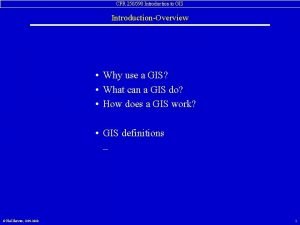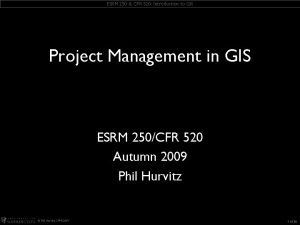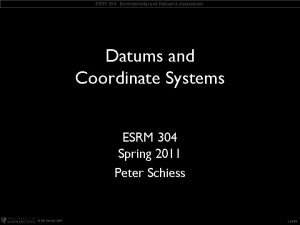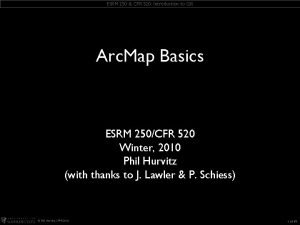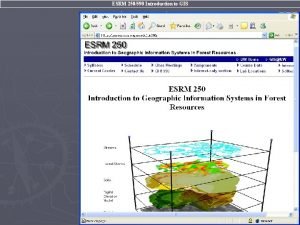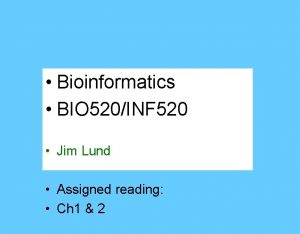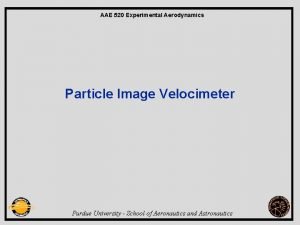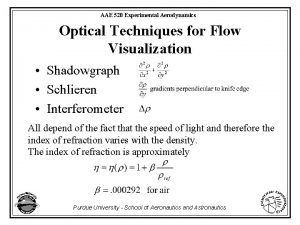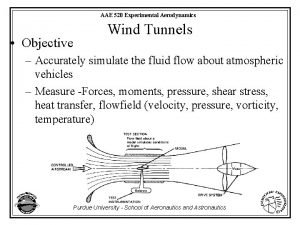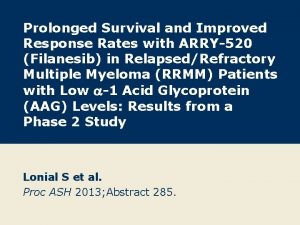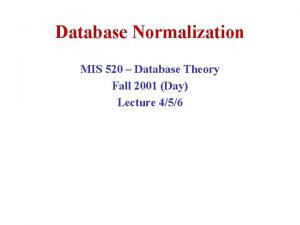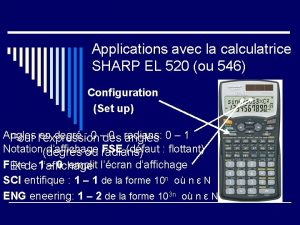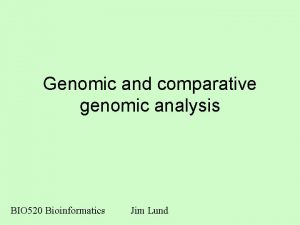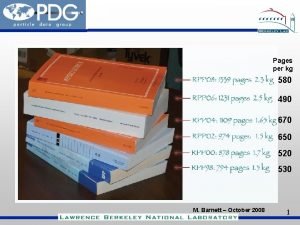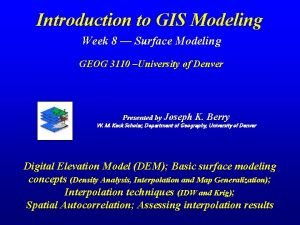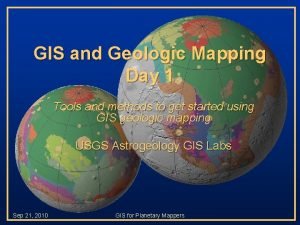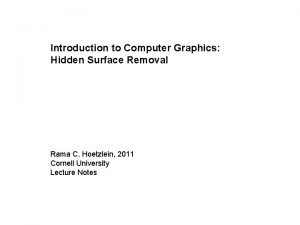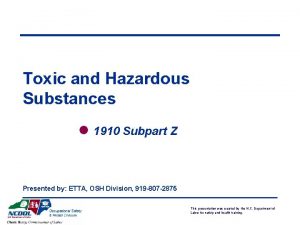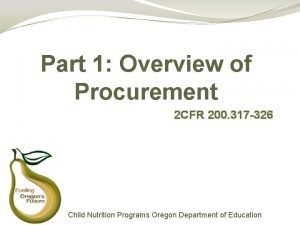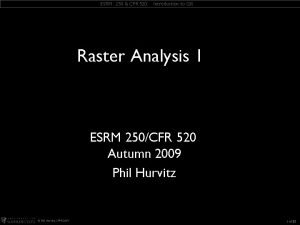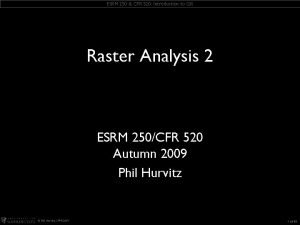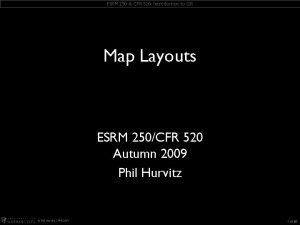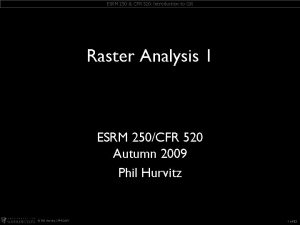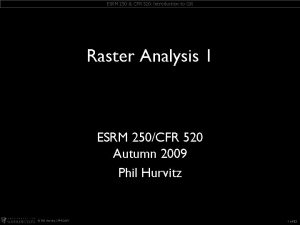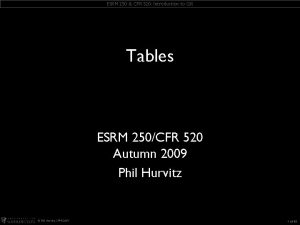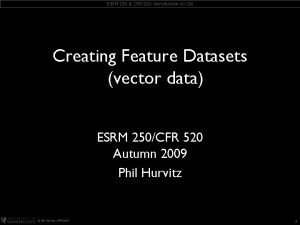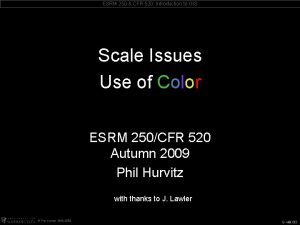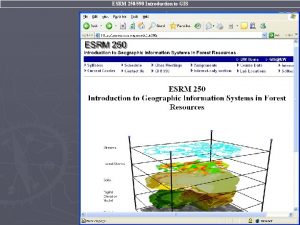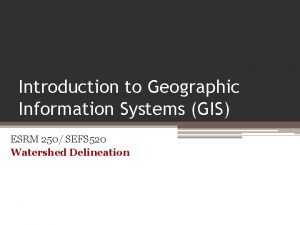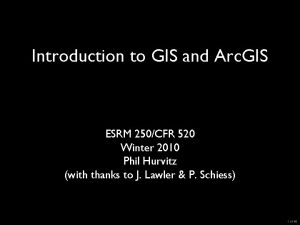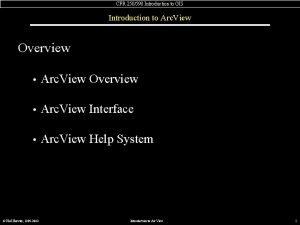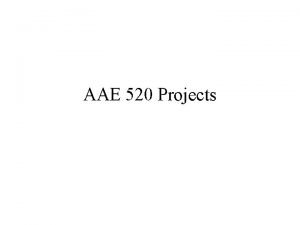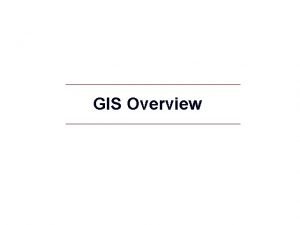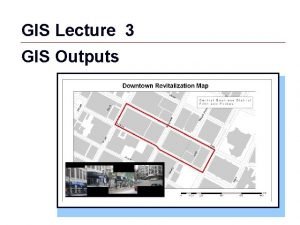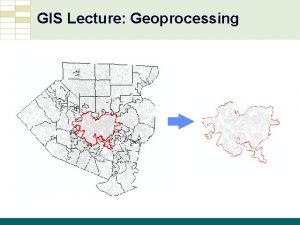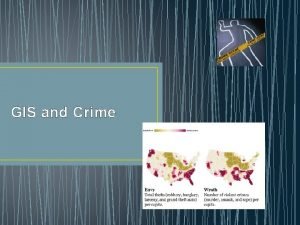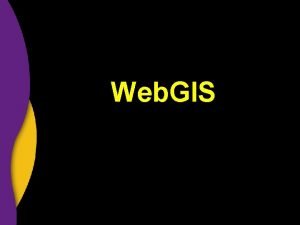ESRM 250 CFR 520 Introduction to GIS Surface









































- Slides: 41

ESRM 250 & CFR 520: Introduction to GIS Surface Hydrologic Modeling (Watershed Delineation) ESRM 250/CFR 520 Autumn 2009 Phil Hurvitz © Phil Hurvitz, 1999 -2009 1 of 40

ESRM 250 & CFR 520: Introduction to GIS Overview Watershed management Definitions Algorithms & Watershed delineation Automatically delineating watersheds Flow length Raster to vector conversion © Phil Hurvitz, 1999 -2009 2 of 40

ESRM 250 & CFR 520: Introduction to GIS Overview Watershed management Definitions Algorithms & Watershed delineation Automatically delineating watersheds Flow length Raster to vector conversion © Phil Hurvitz, 1999 -2009 3 of 40

ESRM 250 & CFR 520: Introduction to GIS Watershed management Important topic in modern landscape management In the past, landscapes have been managed by ownership Plant & animal species do not obey ownership boundaries Need for physically or biologically based land divisions © Phil Hurvitz, 1999 -2009 4 of 40

ESRM 250 & CFR 520: Introduction to GIS Watershed management © Phil Hurvitz, 1999 -2009 5 of 40

ESRM 250 & CFR 520: Introduction to GIS Watershed management Watersheds are physically & biologically meaningful Various interest groups can agree on watershed boundaries Watersheds are easily defined based on elevation models Management activities applied on watershed-bywatershed basis © Phil Hurvitz, 1999 -2009 6 of 40

ESRM 250 & CFR 520: Introduction to GIS Overview Watershed management Definitions Algorithms & Watershed delineation Automatically delineating watersheds Flow length Raster to vector conversion © Phil Hurvitz, 1999 -2009 7 of 40

ESRM 250 & CFR 520: Introduction to GIS Definition of watershed “The region draining into a river, river system, or body of water” American Heritage Dictionary þ The upstream area of any given point on the landscape þ Physically defined by drainage point and upstream area þ Also known as basin, sub-basin, catchment, and contributing area © Phil Hurvitz, 1999 -2009 8 of 40

ESRM 250 & CFR 520: Introduction to GIS Definition of watershed A watershed can be defined at a broad regional scale, such as the Columbia River watershed or. . . © Phil Hurvitz, 1999 -2009 9 of 40

ESRM 250 & CFR 520: Introduction to GIS Definition of watershed At a small local scale, such as the Husky Stadium watershed © Phil Hurvitz, 1999 -2009 10 of 40

ESRM 250 & CFR 520: Introduction to GIS Overview Watershed management Definitions Algorithms & Watershed delineation Automatically delineating watersheds Flow length Raster to vector conversion © Phil Hurvitz, 1999 -2009 11 of 40

ESRM 250 & CFR 520: Introduction to GIS How it works: algorithm Axiom: Water always flows downhill þ For any point on a raster representing a landscape, a drop of water can be traced downhill þ þ For any point on a raster representing a landscape, a flow pathway can be traced back uphill þ þ þ Direction of flow can be determined for every DEM cell Flow accumulation can be calculated for every DEM cell Uphill back-tracing proceeds to a ridgeline or to the edge of the grid Termination of uphill back-tracing defines the watershed boundary © Phil Hurvitz, 1999 -2009 12 of 40

ESRM 250 & CFR 520: Introduction to GIS Watershed delineation: Steps Watershed delineation steps are available in Arc. Toolbox: 1. 2. 3. 4. 5. Create a depressionless DEM Calculate flow direction Calculate flow accumulation Create watershed Pour points Delineate watersheds © Phil Hurvitz, 1999 -2009 13 of 40

ESRM 250 & CFR 520: Introduction to GIS Watershed delineation: Steps © Phil Hurvitz, 1999 -2009 14 of 40

ESRM 250 & CFR 520: Introduction to GIS Watershed delineation: Creating a depressionless DEM must eventually drain off edge of grid Areas of internal drainage will result in unprocessed areas þ FILL routine fills in sinks or cuts off peaks creating a new grid with no drainage errors elevation þ © Phil Hurvitz, 1999 -2009 15 of 40

ESRM 250 & CFR 520: Introduction to GIS Watershed delineation: Flow direction Every cell flows into another cell or off the grid edge Flow direction is calculated as the direction of steepest downward descent þ Flow direction is stored in numerically-coded schema þ Flow direction values are not ratio or proportional þ Flow direction is calculated for each cell, resulting in a new grid theme þ © Phil Hurvitz, 1999 -2009 16 of 40

ESRM 250 & CFR 520: Introduction to GIS Watershed delineation: Flow direction values are encoded in a raster direction of flow is saved as a code number flow moves out of a cell in one of 8 directions © Phil Hurvitz, 1999 -2009 17 of 40

ESRM 250 & CFR 520: Introduction to GIS Watershed delineation: Flow direction This is a bookkeeping scheme, not a ratio or proportion representing a measured phenomenon north-flowing cells © Phil Hurvitz, 1999 -2009 coded as 64 18 of 40

ESRM 250 & CFR 520: Introduction to GIS Watershed delineation: Flow direction Individual cells/zones in the grid are coded for flow direction © Phil Hurvitz, 1999 -2009 19 of 40

ESRM 250 & CFR 520: Introduction to GIS Watershed delineation: Flow direction Individual cells/zones in the grid are coded for flow direction © Phil Hurvitz, 1999 -2009 20 of 40

ESRM 250 & CFR 520: Introduction to GIS Watershed delineation: Flow direction Individual cells/zones in the grid are coded for flow direction © Phil Hurvitz, 1999 -2009 20 of 40

ESRM 250 & CFR 520: Introduction to GIS Watershed delineation: Flow accumulation Each has just been coded for direction of flow Cumulative flow is calculated from flow direction þ Output grid is created where values are the number of tributary (upstream) cells þ Lower accumulation values are ridge tops þ Higher accumulation values are valleys & stream channels þ © Phil Hurvitz, 1999 -2009 21 of 40

ESRM 250 & CFR 520: Introduction to GIS Watershed delineation: Flow accumulation Higher-flow cells have a larger value 3 5 1 © Phil Hurvitz, 1999 -2009 22 of 40

ESRM 250 & CFR 520: Introduction to GIS Watershed delineation: Flow accumulation Higher-flow cells have a greater value © Phil Hurvitz, 1999 -2009 23 of 40

ESRM 250 & CFR 520: Introduction to GIS Watershed delineation: Flow accumulation Legend can be altered to show only high-flow cells a single class legend to show only those cells above a threshold of flow accumulation © Phil Hurvitz, 1999 -2009 24 of 40

ESRM 250 & CFR 520: Introduction to GIS Watershed delineation: Flow accumulation Generated flow network should fit closely with reality only if: DEM matches ground condition Streams match ground condition note discrepancies © Phil Hurvitz, 1999 -2009 25 of 40

ESRM 250 & CFR 520: Introduction to GIS Watershed delineation: Watershed “Pour points” Watersheds are defined by outlets (pour points) Pour points should be placed in high-flow pathways þ Basins will be generated from pour point to ridgeline or to upstream sub-basin þ Pour points should be numerically coded per subbasin þ Pour points should be converted to a grid layer þ © Phil Hurvitz, 1999 -2009 26 of 40

ESRM 250 & CFR 520: Introduction to GIS Watershed delineation: Watershed Pour points Create as many pour points as necessary Zoom in to place pour point in center of high-flow cell © Phil Hurvitz, 1999 -2009 27 of 40

ESRM 250 & CFR 520: Introduction to GIS Watershed delineation: Delineating watersheds Preliminary steps are completed Filled DEM þ Flow direction þ Flow accumulation þ Pour points created & converted to grid þ Run tool to create watersheds © Phil Hurvitz, 1999 -2009 28 of 40

ESRM 250 & CFR 520: Introduction to GIS Watershed delineation: Delineating watersheds Watersheds represent area upstream from pour points Watersheds terminate at ridgelines, uphill sub-basin boundary, or edge of the raster © Phil Hurvitz, 1999 -2009 29 of 40

ESRM 250 & CFR 520: Introduction to GIS Watershed delineation: Delineating watersheds Clearly visible with analytically hillshaded DEM Watershed boundaries stop at ridgelines © Phil Hurvitz, 1999 -2009 30 of 40

ESRM 250 & CFR 520: Introduction to GIS Overview Watershed management Definitions Algorithms & Watershed delineation Automatically delineating watersheds Flow length Raster to vector conversion © Phil Hurvitz, 1999 -2009 31 of 40

ESRM 250 & CFR 520: Introduction to GIS Watershed delineation: Automatic delineation Basin tool No user control þ Pour points automatically selected by “intersection” of highest-flow pathways and grid edge þ © Phil Hurvitz, 1999 -2009 32 of 40

ESRM 250 & CFR 520: Introduction to GIS Watershed delineation: Automatic delineation Basin tool © Phil Hurvitz, 1999 -2009 33 of 40

ESRM 250 & CFR 520: Introduction to GIS Overview Watershed management Definitions Algorithms & Watershed delineation Automatically delineating watersheds Flow length Raster to vector conversion © Phil Hurvitz, 1999 -2009 34 of 40

ESRM 250 & CFR 520: Introduction to GIS Flow length Flow distance for every cell to outlet © Phil Hurvitz, 1999 -2009 35 of 40

ESRM 250 & CFR 520: Introduction to GIS Flow length Flow distance for every cell to closest stream © Phil Hurvitz, 1999 -2009 36 of 40

ESRM 250 & CFR 520: Introduction to GIS Overview Watershed management Definitions Algorithms & Watershed delineation Automatically delineating watersheds Flow length Raster to vector conversion © Phil Hurvitz, 1999 -2009 37 of 40

ESRM 250 & CFR 520: Introduction to GIS Raster to vector conversion Conversion from rasters to lines or polygons Stream network as line shape þ Stream links as points þ Stream order (Strahler or Shreve) þ Watershed grid theme a polygon theme þ © Phil Hurvitz, 1999 -2009 38 of 40

ESRM 250 & CFR 520: Introduction to GIS Raster to vector conversion Display watersheds with other data sets to verify modeling © Phil Hurvitz, 1999 -2009 39 of 40

ESRM 250 & CFR 520: Introduction to GIS Raster to vector conversion Watershed themes can be incorporated with other raster & vector analysis methods Road & stream densities þ Forest age analysis þ Sedimentation effects þ Habitat area in different basins þ Animal movement analysis þ © Phil Hurvitz, 1999 -2009 40 of 40
 Confirmed revenue passenger oversales
Confirmed revenue passenger oversales Cfr 250
Cfr 250 Esrm cad download
Esrm cad download Esrm national grid
Esrm national grid Gisarc
Gisarc Esrmcad
Esrmcad Esrm software
Esrm software Dts garage motor
Dts garage motor Act 520
Act 520 Csc520
Csc520 Kni 520
Kni 520 How much work is done on a small car of a 3150
How much work is done on a small car of a 3150 12vac35-105-520
12vac35-105-520 Lund bioinformatics
Lund bioinformatics Aae 520
Aae 520 Aae 520
Aae 520 Aae 520
Aae 520 Arry-520
Arry-520 3nf decomposition example
3nf decomposition example Opwekking 510 tekst
Opwekking 510 tekst Www.rigexpert.com
Www.rigexpert.com Hl 520
Hl 520 Nep 520
Nep 520 F 520
F 520 Sharp el-520
Sharp el-520 520 bc
520 bc Bio 520
Bio 520 650-520
650-520 Ead 520
Ead 520 Introduction to gis
Introduction to gis Introduction to gis
Introduction to gis Gis
Gis Triangular prism total surface area
Triangular prism total surface area High surface tension vs low surface tension
High surface tension vs low surface tension Curved surface area and total surface area of cone
Curved surface area and total surface area of cone Introduction to hidden surface removal
Introduction to hidden surface removal 1910 subpart h
1910 subpart h Osha z tables
Osha z tables 29 cfr 1910
29 cfr 1910 29 cfr 1910
29 cfr 1910 21 cfr part 11 questions and answers
21 cfr part 11 questions and answers 2 cfr 200 procurement thresholds
2 cfr 200 procurement thresholds

